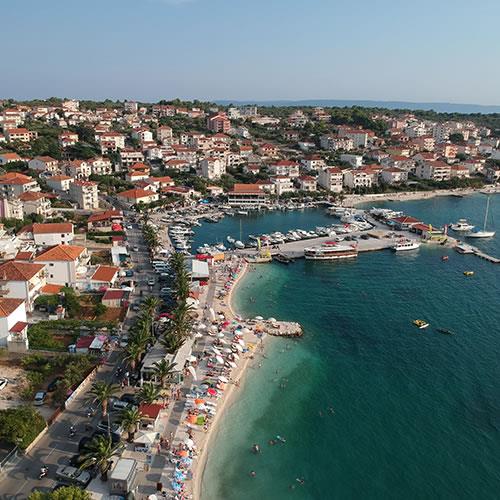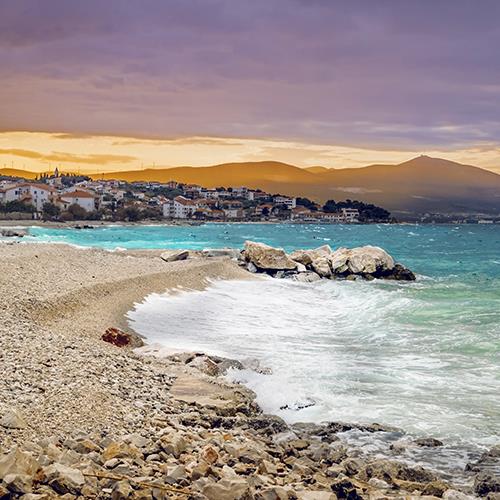Day 1 in Trogir
Welcome to Croatia! Upon arrival, you will go through customs and immigration. Should you opt to purchase a transfer to your hotel, a representative will be waiting for you as you exit immigration. Otherwise, make your way to Trogir and arrive at your hotel. Check in and do not give in to jet lag! There is so much for you to see and do!
On the first day, explore some of the best-known sights inside the Historic City of Trogir. Built on an island between the Dalmatian mainland and Ciovo Island, the layout of the city streets in the UNESCO World Heritage-certified historic core has been roughly same since the era of the Ancient Greeks, who knew this city as Tragyrion. You will enter town by crossing Trogir Bridge and, as you decide whether to turn left or right into the city, you will see a stone archway called the Land Gate. In olden times, that was how people would enter the walled city.
Turn left and venture along the road that wraps around the island. In about 500 feet, on the right you will see the city`s most famous landmark, the 13th-century Church of St. Lawrence (Trogir Cathedral). Built on the site of a church that was originally built in the tenth or eleventh century, the Church of St. Lawrence is well-known for its Romanesque, Gothic, and Mannerist architectural design characteristics, and for the ornate Portal of Radovan.
After visiting the Cathedral, take some time to look around the main square, John Paul II Square. Trogir`s city hall is the 13th-century Duke`s Palace, located on the square. Also on the square, or adjacent to it, you will find the city loggia, St. Sebastian`s Church, and the dual Cipiko Palaces, all dating from the 15th century. Decide on a museum you`d like to see; if you have time, see both. North of Cipiko Palace you will find the Trogir City Museum, which showcases Trogir`s history all the way back to the time of the Ancient Greeks. Next to St. Sebastian`s Church, the Museum of Sacred Art boasts a collection of Venetian and Dalmatian paintings from as far back as the 14th century. To give you an idea of the size of the Historic City of Trogir, it is laid out across 28 acres, or about one-quarter of the size of the Mall of America.
In the evening, go back to the road along the perimeter of the historic city and head south to the waterfront, where you can stroll the southern side of the city and find a place to enjoy a leisurely dinner. Note the stone door on the southern side of the island; it is called Sea Gate and that was how people coming by sea entered the walled city hundreds of years ago. Return to your accommodations at the end of the evening.



Day 2 in Trogir
After breakfast, walk to the western end of the historic city and tour Kamerlengo Fortress (Kaštel), built out of limestone by the Venetians. The best-preserved sections of the old city walls are found at and around the fortress. St. Mark`s Tower on the northern end opposite Kamerlengo Fortress protected the northern channel between the city and the mainland. You will find between the two defenses there is a soccer field. Trogir`s soccer club, HNK Trogir, started playing their matches here in April 2019. Where else can you watch a soccer game while wedged between two historic sites in a UNESCO World Heritage-protected area?
Five hundred feet to the east of St. Mark`s Tower, there is a wooden bridge, which is pedestrian-only and offers easy access to the Trogir Green Market, which sits just next to Trogir Bridge. Stop by the market and pick up a snack, because you are going to go to the beach this afternoon! The two popular beaches in the area are Trogir City Beach, a half-mile to the east of Trogir Green Market and Trogir Bridge, and Okrug Gornji Beach, located five miles away on the western coast of Ciovo Island, connected to the historic city by the Old Ciovo Bridge. (The multi-span New Ciovo Bridge is located past the city beach.) There are a couple of cafés at the city beach, but if bars and restaurants are what you`re looking for, head to Okrug Gornji. Return to your accommodations at the end of the day.


Additional Days in Trogir
Consider spending more time on Ciovo Island, which sits just to the south of the historic city. Ciovo`s status as a easygoing and relaxing beach destination is a far cry from its reputation in the Middle Ages when it housed a leper colony! The western side of Ciovo is dominated by the twin beachside settlements of Okrug Donji and Okrug Gornji, which have grown to also accommodate middle and upper-class houses as families from nearby Trogir move to the suburbs. On the northern coast, there are three small beachfront communities geared toward tourists: Mastrinka, Arbanija, and Slatine. Ciovo is a great place to enjoy water sports like parasailing and jet skiing, and Trogir`s nightlife scene is increasingly centered along the western coast.

Your Last Day in Trogir
Depart your hotel and head to the airport for your return home. If self-driving, please return your rental car to the place noted on your reservation (usually the airport, but double-check to make sure). If you are purchasing a private transfer, a representative will meet you at the hotel in time to take you to the airport for your flight out. We hope you enjoyed the sights of Trogir!
